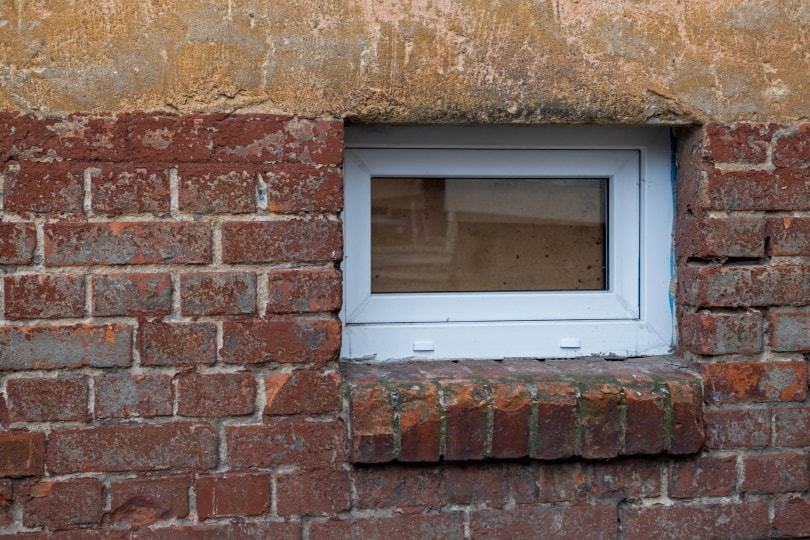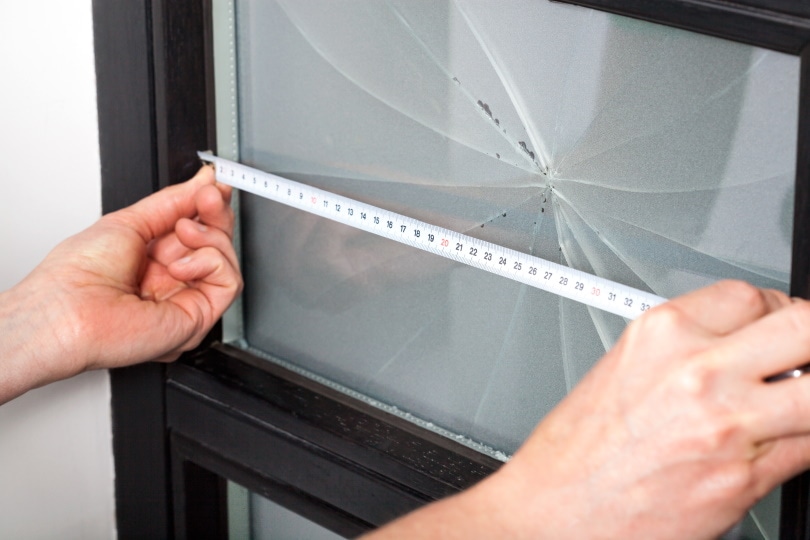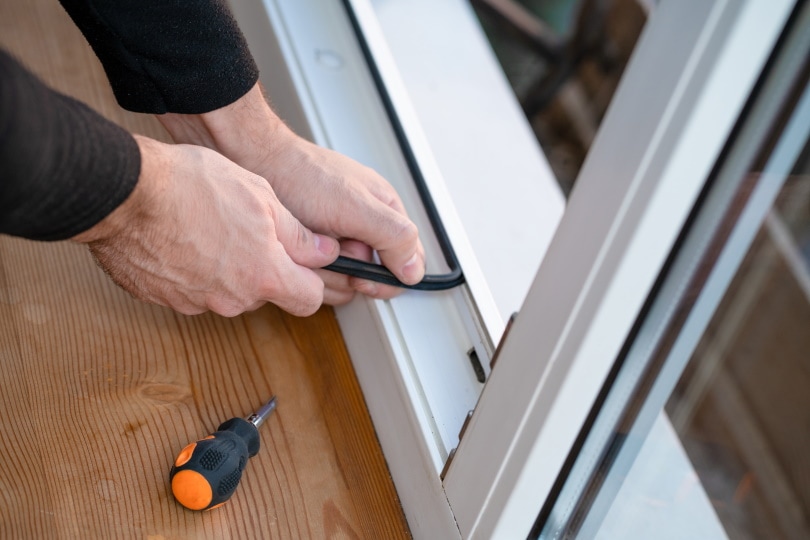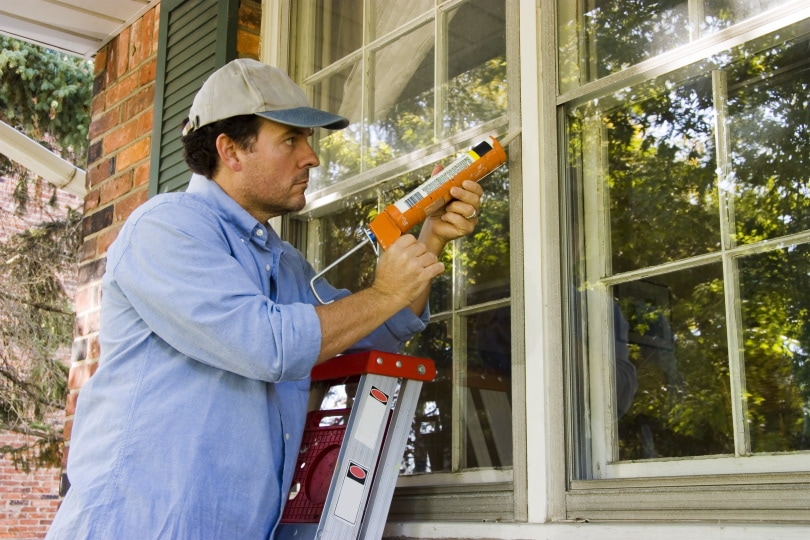How to Replace Basement Windows in 10 Steps
-
Shea Cummings
- Last updated:

Replacing a basement window might sound like a job for a professional, but it’s actually quite doable if you have the knowledge and the right guidance. That’s where we come in. We’ll show you how to replace a basement window in 10 steps. However, the first step always begins with preparation!

Before You Begin
Here is a list of tools and supplies to ensure you have before you begin replacing your basement window. In addition to these things, make sure you prepare your work area. Make sure that kids or pets will not get in the way. Also, if there is furniture or anything else in the way that may pose a tripping hazard while you are working, be sure to move it.
| Safety | work gloves, safety glasses |
| Materials | replacement window, 2×4 lumber, expansion foam, window trim, joint and seam filler, exterior-rated calking |
| Tools | 24-inch level, chisel, hammer, broom, knife, circular saw, drill (and screws), caulking gun |
| Optional | vacuum, reciprocating saw, miter saw |
How to Replace Basement Windows (10 Steps)
1. Measure for New Window
Before you begin ripping out the window you are replacing, you need to do a couple of things. Because if you take out the old window before you are prepared, you may find yourself with a hole in the basement and nothing to put in it. If you need to order a new window, it could take a few weeks to arrive at your building center.
The first thing you need to do is determine whether the window and frame both need to be replaced or just the window. If the frame is not rotted or warped, you may be able to replace just the glass. If this is the case, measure the height and width of the existing glass and take those measurements to your local building center. If you determine the frame needs to be replaced, measure the height and width of the whole window.
If you cannot order the exact size to replace the existing window, get the closest size under because expanding foam will fill that gap and secure the window.

2. Remove Old Window
Now that you’ve picked up your new window, it’s time to get to work. Make sure that you have the time to complete the project before you start tearing because once you start, you’re not going to want to leave it unfinished.
Protecting yourself is the first task. Make sure you put on leather work gloves to protect your hands and safety glasses to protect against any flying debris during the demolition phase.
In the case of a wooden window, it is a relatively straightforward process. Using a hammer and pry bar, you will be able to remove the old sash. Once you do this, you should be able to access and remove the screws holding the window in place. With the screws removed, slide the window out. You may need to use your knife to separate the window from expanding foam in some cases. A reciprocating saw can usually get the job done if a knife doesn’t work.
If the old window has a metal frame, you must first check whether it is screwed or riveted in place. If it is screwed, simply remove the screws and slide the window out. However, if it is riveted, you will need to drill the rivets out first.
3. Prepare Opening for New Window
Once you’ve safely disposed of the old window, you may have a very rough opening. If the concrete foundation was poured after the original window was installed, there will likely be a rough concrete lip to smooth out.
After you’ve got a smooth surface all the way around, make sure you give the area a thorough sweep or vacuum. Giving yourself a clean space to work with will make the rest of the process much easier.

4. Install Bucks
If the foundation is concrete, you will have to install new bucks if the old ones were rotted or warped. First, measure the four sides of the opening. Then from the 2×4 board, cut four pieces to fit snugly inside the opening. Apply a joint and seam filler and attach each board with masonry screws.
5. Put Window in Place
This step goes much easier with a helper, but if you are on your own, there are a couple of tricks as long as you can lift the new window yourself. First place approximately a ½ inch of shims where the window will sit. Without knocking your shims over, tilt the window so you can extend the whole thing through the window. Straighten it out and pull it back in against the outside wall and rest it on the shims.
The window would then be straight in a perfect world, but it never goes that way, especially with renovations.
Lay your level across the bottom of the window. Shim up and down on each side accordingly until it is perfectly level. Also, make sure that there is an approximately even gap on each side. Once you have a level window and even openings on each side. Shim the sides snug as well; this will make screwing in the window easier.

Note: It is essential you get the window perfectly level at this point, or it may not open and close properly.
6. Secure Window
Some windows will have specific areas marked for where to screw. If yours doesn’t, doing it inside the sill works well because the screws will be hidden when the window is closed.
The key thing to remember when putting in the screws is not to over-tighten as this can severely damage the window and pull it out of square. A good rule of thumb is to screw until it just starts to pull and back the screw off slightly because the main goal here is to secure it while you spray in the expanding foam. Two screws (top and bottom) on each side will be more than sufficient.
In some situations, you could even forgo screwing the window, but it is usually advised.
7. Apply Expansion Foam
At this point, you don’t want to get carried away with the expansion foam because it creates a disastrous mess if it gets where you don’t want it. If you’re not familiar with expansion foam, it may be a good idea to squirt a little bit in a garbage bin so you can get a good idea of how much it will expand.
Once you are ready to apply it around the space between the window and the buck, stick the nozzle and apply the foam in a steady motion around the window. Allow it to expand. Once it has expanded as much as it will, you can add some more if you need to. If some of it extends past the edge of the window, wait until it cures, and you will be able to cut it off clean and flush with a knife.

8. Caulk Exterior Seam of Window
Make sure you are using outdoor caulking made for windows. A significant reason for this is that the caulking stays a little flexible even once it is cured. It also creates a weather-tight seal that won’t erode quickly by sun or weather. Clean up any messes before the caulking dries.
9. Prime Window Frame (Or Seal)
If you’ve just installed a wooden framed window, it’s important that you prime or seal the wood—especially the exterior, but it’s a good idea to do the interior as well. Any primer or clearcoat rated for exterior use will be acceptable. Follow the manufacturer’s instructions for application and drying times listed on the container.

10. Install Trim around Interior Window Frame
Trim is the nicest and easiest way to finish the interior of your window frame. There are a couple of tips to keep in mind for the trim installation. First, prime the trim once before cutting and installing to save on effort once it’s up. Second, add a little bit of wood glue to your mitered joints to help prevent joint separation as the wood expands and contracts.
 Things to Keep in Mind When Fixing Basement Windows
Things to Keep in Mind When Fixing Basement Windows
- Measure twice, cut once!
- Always follow the manufacturer’s directions on all containers and packaging.
- Overkill is almost always better than not.
- Take your time, especially if this is the first window you have changed. Sometimes missing something can result in starting over and can get expensive.

Conclusion
And there you have it! If you follow these simple but effective steps, you can replace a bedroom window yourself and save yourself a ton of money in the process!
Featured Image Credit: ANDY RELY, Shutterstock
Contents

 Things to Keep in Mind When Fixing Basement Windows
Things to Keep in Mind When Fixing Basement Windows